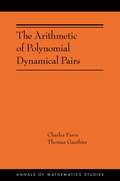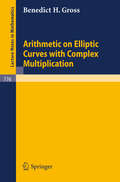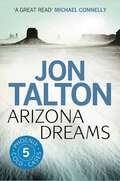- Table View
- List View
The Arithmetic of Infinitesimals (Sources and Studies in the History of Mathematics and Physical Sciences)
by John WallisJohn Wallis (1616-1703) was the most influential English mathematician prior to Newton. He published his most famous work, Arithmetica Infinitorum, in Latin in 1656. This book studied the quadrature of curves and systematised the analysis of Descartes and Cavelieri. Upon publication, this text immediately became the standard book on the subject and was frequently referred to by subsequent writers. This will be the first English translation of this text ever to be published.
Arithmetic of p-adic Modular Forms (Lecture Notes in Mathematics #1304)
by Fernando Q. GouveaThe central topic of this research monograph is the relation between p-adic modular forms and p-adic Galois representations, and in particular the theory of deformations of Galois representations recently introduced by Mazur. The classical theory of modular forms is assumed known to the reader, but the p-adic theory is reviewed in detail, with ample intuitive and heuristic discussion, so that the book will serve as a convenient point of entry to research in that area. The results on the U operator and on Galois representations are new, and will be of interest even to the experts. A list of further problems in the field is included to guide the beginner in his research. The book will thus be of interest to number theorists who wish to learn about p-adic modular forms, leading them rapidly to interesting research, and also to the specialists in the subject.
The Arithmetic of Polynomial Dynamical Pairs: (AMS-214) (Annals of Mathematics Studies #401)
by Charles Favre Thomas GauthierNew mathematical research in arithmetic dynamicsIn The Arithmetic of Polynomial Dynamical Pairs, Charles Favre and Thomas Gauthier present new mathematical research in the field of arithmetic dynamics. Specifically, the authors study one-dimensional algebraic families of pairs given by a polynomial with a marked point. Combining tools from arithmetic geometry and holomorphic dynamics, they prove an “unlikely intersection” statement for such pairs, thereby demonstrating strong rigidity features for them. They further describe one-dimensional families in the moduli space of polynomials containing infinitely many postcritically finite parameters, proving the dynamical André-Oort conjecture for curves in this context, originally stated by Baker and DeMarco.This is a reader-friendly invitation to a new and exciting research area that brings together sophisticated tools from many branches of mathematics.
Arithmetic of Quadratic Forms (Springer Monographs in Mathematics #109)
by Goro ShimuraThis book is divided into two parts. The first part is preliminary and consists of algebraic number theory and the theory of semisimple algebras. There are two principal topics: classification of quadratic forms and quadratic Diophantine equations. The second topic is a new framework which contains the investigation of Gauss on the sums of three squares as a special case. To make the book concise, the author proves some basic theorems in number theory only in some special cases. However, the book is self-contained when the base field is the rational number field, and the main theorems are stated with an arbitrary number field as the base field. So the reader familiar with class field theory will be able to learn the arithmetic theory of quadratic forms with no further references.
Arithmetic on Elliptic Curves with Complex Multiplication (Lecture Notes in Mathematics #776)
by B.H. GrossArithmetic on Modular Curves (Progress in Mathematics #20)
by G. StevensOne of the most intriguing problems of modern number theory is to relate the arithmetic of abelian varieties to the special values of associated L-functions. A very precise conjecture has been formulated for elliptic curves by Birc~ and Swinnerton-Dyer and generalized to abelian varieties by Tate. The numerical evidence is quite encouraging. A weakened form of the conjectures has been verified for CM elliptic curves by Coates and Wiles, and recently strengthened by K. Rubin. But a general proof of the conjectures seems still to be a long way off. A few years ago, B. Mazur [26] proved a weak analog of these c- jectures. Let N be prime, and be a weight two newform for r 0 (N) . For a primitive Dirichlet character X of conductor prime to N, let i\ f (X) denote the algebraic part of L (f , X, 1) (see below). Mazur showed in [ 26] that the residue class of Af (X) modulo the "Eisenstein" ideal gives information about the arithmetic of Xo (N). There are two aspects to his work: congruence formulae for the values Af(X) , and a descent argument. Mazur's congruence formulae were extended to r 1 (N), N prime, by S. Kamienny and the author [17], and in a paper which will appear shortly, Kamienny has generalized the descent argument to this case.
Arithmetic Tales (Universitext)
by Olivier BordellèsNumber theory was once famously labeled the queen of mathematics by Gauss. The multiplicative structure of the integers in particular deals with many fascinating problems some of which are easy to understand but very difficult to solve. In the past, a variety of very different techniques has been applied to further its understanding.Classical methods in analytic theory such as Mertens’ theorem and Chebyshev’s inequalities and the celebrated Prime Number Theorem give estimates for the distribution of prime numbers. Later on, multiplicative structure of integers leads to multiplicative arithmetical functions for which there are many important examples in number theory. Their theory involves the Dirichlet convolution product which arises with the inclusion of several summation techniques and a survey of classical results such as Hall and Tenenbaum’s theorem and the Möbius Inversion Formula. Another topic is the counting integer points close to smooth curves and its relation to the distribution of squarefree numbers, which is rarely covered in existing texts. Final chapters focus on exponential sums and algebraic number fields. A number of exercises at varying levels are also included. Topics in Multiplicative Number Theory introduces offers a comprehensive introduction into these topics with an emphasis on analytic number theory. Since it requires very little technical expertise it will appeal to a wide target group including upper level undergraduates, doctoral and masters level students.
Arithmetic Tales: Advanced Edition (Universitext)
by Olivier BordellèsThis textbook covers a wide array of topics in analytic and multiplicative number theory, suitable for graduate level courses.Extensively revised and extended, this Advanced Edition takes a deeper dive into the subject, with the elementary topics of the previous edition making way for a fuller treatment of more advanced topics. The core themes of the distribution of prime numbers, arithmetic functions, lattice points, exponential sums and number fields now contain many more details and additional topics. In addition to covering a range of classical and standard results, some recent work on a variety of topics is discussed in the book, including arithmetic functions of several variables, bounded gaps between prime numbers à la Yitang Zhang, Mordell's method for exponential sums over finite fields, the resonance method for the Riemann zeta function, the Hooley divisor function, and many others. Throughout the book, the emphasis is on explicit results.Assuming only familiarity with elementary number theory and analysis at an undergraduate level, this textbook provides an accessible gateway to a rich and active area of number theory. With an abundance of new topics and 50% more exercises, all with solutions, it is now an even better guide for independent study.
Arithmetic Tests for ages 10-11: Preparation for KS2 SATs
by Andrew BrodieThis teacher resource title is designed to match the style and contents of the Arithmetic Tests elements of the new format National Tests. One of the New Maths Arithmetic Tests series, the book provides all the practice your pupils need to build their confidence and boost their ability in the key skills of addition, subtraction, multiplication and division. The book contains forty-eight tests with matching answer pages, enabling teachers to provide short regular practice of non-contextual number questions. The answer pages provide clear answers and show the correct layout for column addition, column subtraction and column multiplication as well as short division and long division. Each book in the series includes 480 non-contextual number questions.
Arithmetic Tests for ages 6-7: Preparation for KS1 SATs
by Andrew BrodieThis teacher resource title is designed to match the style and contents of the Arithmetic Tests elements of the new format National Tests. One of the new Arithmetic Tests series, the book provides all the practice your pupils need to build their confidence and boost their ability in the key skills of addition, subtraction, multiplication and division. The book contains forty-eight tests with matching answer pages, enabling teachers to provide short regular practice of non-contextual number questions. The answer pages provide clear answers and show the correct layout for column addition and column subtraction. Each book in the series includes 480 non-contextual number questions.
Arithmetic Theory of Elliptic Curves: Lectures given at the 3rd Session of the Centro Internazionale Matematico Estivo (C.I.M.E.)held in Cetaro, Italy, July 12-19, 1997 (Lecture Notes in Mathematics #1716)
by J. Coates R. Greenberg K.A. Ribet K. RubinThis volume contains the expanded versions of the lectures given by the authors at the C.I.M.E. instructional conference held in Cetraro, Italy, from July 12 to 19, 1997. The papers collected here are broad surveys of the current research in the arithmetic of elliptic curves, and also contain several new results which cannot be found elsewhere in the literature. Owing to clarity and elegance of exposition, and to the background material explicitly included in the text or quoted in the references, the volume is well suited to research students as well as to senior mathematicians.
The Arithmetica of Diophantus: A Complete Translation and Commentary (Scientific Writings from the Ancient and Medieval World)
by Jean Christianidis Jeffrey OaksThis volume offers an English translation of all ten extant books of Diophantus of Alexandria’s Arithmetica, along with a comprehensive conceptual, historical, and mathematical commentary. Before his work became the inspiration for the emerging field of number theory in the seventeenth century, Diophantus (ca. 3rd c. CE) was known primarily as an algebraist. This volume explains how his method of solving arithmetical problems agrees both conceptually and procedurally with the premodern algebra later practiced in Arabic, Latin, and European vernaculars, and how this algebra differs radically from the modern algebra initiated by François Viète and René Descartes. It also discusses other surviving traces of ancient Greek algebra and follows the influence of the Arithmetica in medieval Islam, Byzantium, and the European Renaissance down to the 1621 publication of Claude-Gaspard Bachet’s edition. After the English translation the book provides a problem-by-problem commentary explaining the solutions in a manner compatible with Diophantus’s mode of thought. The Arithmetica of Diophantus provides an invaluable resource for historians of mathematics, science, and technology, as well as those studying ancient Greek, medieval Islamic and Byzantine, and Renaissance history. In addition, the volume is also suitable for mathematicians and mathematics educators.
Arithmetical Aspects of the Large Sieve Inequality
by Oliver RamaréThis book is an elaboration of a series of lectures given at the Harish-Chandra Research Institute. The reader will be taken through a journey on the arithmetical sides of the large sieve inequality when applied to the Farey dissection. This will reveal connections between this inequality, the Selberg sieve and other less used notions like pseudo-characters and the $\Lambda_Q$-function, as well as extend these theories. One of the leading themes of these notes is the notion of so-called\emph{local models} that throws a unifying light on the subject. As examples and applications, the authors present, among other things, an extension of the Brun-Tichmarsh Theorem, a new proof of Linnik's Theorem on quadratic residues and an equally novel one of the Vinogradov three primes Theorem; the authors also consider the problem of small prime gaps, of sums of two squarefree numbers and several other ones, some of them being new, like a sharp upper bound for the number of twin primes $p$ that are such that $p+1$ is squarefree. In the end the problem of equality in the large sieve inequality is considered and several results in this area are also proved.
Arithmetical Functions (Grundlehren der mathematischen Wissenschaften #167)
by Komaravolu ChandrasekharanThe plan of this book had its inception in a course of lectures on arithmetical functions given by me in the summer of 1964 at the Forschungsinstitut fUr Mathematik of the Swiss Federal Institute of Technology, Zurich, at the invitation of Professor Beno Eckmann. My Introduction to Analytic Number Theory has appeared in the meanwhile, and this book may be looked upon as a sequel. It presupposes only a modicum of acquaintance with analysis and number theory. The arithmetical functions considered here are those associated with the distribution of prime numbers, as well as the partition function and the divisor function. Some of the problems posed by their asymptotic behaviour form the theme. They afford a glimpse of the variety of analytical methods used in the theory, and of the variety of problems that await solution. I owe a debt of gratitude to Professor Carl Ludwig Siegel, who has read the book in manuscript and given me the benefit of his criticism. I have improved the text in several places in response to his comments. I must thank Professor Raghavan Narasimhan for many stimulating discussions, and Mr. Henri Joris for the valuable assistance he has given me in checking the manuscript and correcting the proofs. K. Chandrasekharan July 1970 Contents Chapter I The prime number theorem and Selberg's method § 1. Selberg's fonnula . . . . . . 1 § 2. A variant of Selberg's formula 6 12 § 3. Wirsing's inequality . . . . . 17 § 4. The prime number theorem. .
Arithmetical Investigations: Representation Theory, Orthogonal Polynomials, and Quantum Interpolations (Lecture Notes in Mathematics)
by Shai M. HaranIn this volume the author further develops his philosophy of quantum interpolation between the real numbers and the p-adic numbers. The p-adic numbers contain the p-adic integers Zp which are the inverse limit of the finite rings Z/pn. This gives rise to a tree, and probability measures w on Zp correspond to Markov chains on this tree. From the tree structure one obtains special basis for the Hilbert space L2(Zp,w). The real analogue of the p-adic integers is the interval [-1,1], and a probability measure w on it gives rise to a special basis for L2([-1,1],w) - the orthogonal polynomials, and to a Markov chain on "finite approximations" of [-1,1]. For special (gamma and beta) measures there is a "quantum" or "q-analogue" Markov chain, and a special basis, that within certain limits yield the real and the p-adic theories. This idea can be generalized variously. In representation theory, it is the quantum general linear group GLn(q)that interpolates between the p-adic group GLn(Zp), and between its real (and complex) analogue -the orthogonal On (and unitary Un )groups. There is a similar quantum interpolation between the real and p-adic Fourier transform and between the real and p-adic (local unramified part of) Tate thesis, and Weil explicit sums.
Arithmetically Cohen-Macaulay Sets of Points in P^1 x P^1 (SpringerBriefs in Mathematics #0)
by Elena Guardo Adam Van TuylThis brief presents a solution to the interpolation problem for arithmetically Cohen-Macaulay (ACM) sets of points in the multiprojective space P^1 x P^1. It collects the various current threads in the literature on this topic with the aim of providing a self-contained, unified introduction while also advancing some new ideas. The relevant constructions related to multiprojective spaces are reviewed first, followed by the basic properties of points in P^1 x P^1, the bigraded Hilbert function, and ACM sets of points. The authors then show how, using a combinatorial description of ACM points in P^1 x P^1, the bigraded Hilbert function can be computed and, as a result, solve the interpolation problem. In subsequent chapters, they consider fat points and double points in P^1 x P^1 and demonstrate how to use their results to answer questions and problems of interest in commutative algebra. Throughout the book, chapters end with a brief historical overview, citations of related results, and, where relevant, open questions that may inspire future research. Graduate students and researchers working in algebraic geometry and commutative algebra will find this book to be a valuable contribution to the literature.
Arithmetics (Universitext)
by Marc HindryNumber theory is a branch of mathematics which draws its vitality from a rich historical background. It is also traditionally nourished through interactions with other areas of research, such as algebra, algebraic geometry, topology, complex analysis and harmonic analysis. More recently, it has made a spectacular appearance in the field of theoretical computer science and in questions of communication, cryptography and error-correcting codes. Providing an elementary introduction to the central topics in number theory, this book spans multiple areas of research. The first part corresponds to an advanced undergraduate course. All of the statements given in this part are of course accompanied by their proofs, with perhaps the exception of some results appearing at the end of the chapters. A copious list of exercises, of varying difficulty, are also included here. The second part is of a higher level and is relevant for the first year of graduate school. It contains an introduction to elliptic curves and a chapter entitled “Developments and Open Problems”, which introduces and brings together various themes oriented toward ongoing mathematical research. Given the multifaceted nature of number theory, the primary aims of this book are to: - provide an overview of the various forms of mathematics useful for studying numbers - demonstrate the necessity of deep and classical themes such as Gauss sums - highlight the role that arithmetic plays in modern applied mathematics - include recent proofs such as the polynomial primality algorithm - approach subjects of contemporary research such as elliptic curves - illustrate the beauty of arithmetic The prerequisites for this text are undergraduate level algebra and a little topology of Rn. It will be of use to undergraduates, graduates and phd students, and may also appeal to professional mathematicians as a reference text.
Arius Didymus on Peripatetic Ethics, Household Management, and Politics: Text, Translation, and Discussion (Rutgers University Studies in Classical Humanities)
by William W. FortenbaughThis volume features a unique epitome (original summation) of Aristotelian practical philosophy. It is often attributed to Arius Didymus who composed a survey of Peripatetic thought on three closely related areas: ethics, household management, and politics. The quality of the epitome, which draws not only on the surviving treatises of Aristotle, but also on works by later Peripatetics, is excellent. In recent years the epitome has attracted increased attention as an important document for the understanding of Hellenistic philosophy. This new edition of the Greek text is much needed; the most recent edition dates from 1884 and is seriously faulty. This translation, provided by Georgia Tsouni, is based on the oldest and best manuscripts and takes account of recent discussions of difficult passages. In addition, an English translation appears opposite the Greek text on facing pages. The text-translation is followed by nine essays, which are written for a wide audience—not only philosophers and classicists, but also scholars interested in politics and social order. The essays also consider issues of a more philological nature: Who in fact was the author of the epitome? Is Theophrastus an important source? In discussing political matters, is the author intending to defend the practice of philosophy in Augustan Rome? Was there a second epitome, perhaps with a different slant, that has been lost?
Arius Didymus on Peripatetic Ethics, Household Management, and Politics: Text, Translation, and Discussion (Rutgers University Studies in Classical Humanities)
by William W. FortenbaughThis volume features a unique epitome (original summation) of Aristotelian practical philosophy. It is often attributed to Arius Didymus who composed a survey of Peripatetic thought on three closely related areas: ethics, household management, and politics. The quality of the epitome, which draws not only on the surviving treatises of Aristotle, but also on works by later Peripatetics, is excellent. In recent years the epitome has attracted increased attention as an important document for the understanding of Hellenistic philosophy. This new edition of the Greek text is much needed; the most recent edition dates from 1884 and is seriously faulty. This translation, provided by Georgia Tsouni, is based on the oldest and best manuscripts and takes account of recent discussions of difficult passages. In addition, an English translation appears opposite the Greek text on facing pages. The text-translation is followed by nine essays, which are written for a wide audience—not only philosophers and classicists, but also scholars interested in politics and social order. The essays also consider issues of a more philological nature: Who in fact was the author of the epitome? Is Theophrastus an important source? In discussing political matters, is the author intending to defend the practice of philosophy in Augustan Rome? Was there a second epitome, perhaps with a different slant, that has been lost?
Arizona
by Malcolm L. ComeauxThis systematic study of the geography of Arizona emphasizes the relationship between the human population and the environment-the patterns of human activities and their effects on the landscape. Dr. Comeaux introduces Arizona's physical features, then traces its history from the time of the early Indians. A discussion of the state's contemporary population and the rapid growth of its cities is followed by a geographic approach to a number of key topics: Arizona's industries-manufacturing, mining, agriculture, lumber, ranching, and tourism-water and land use, and recreation.
Arizona
by Malcolm L. ComeauxThis systematic study of the geography of Arizona emphasizes the relationship between the human population and the environment-the patterns of human activities and their effects on the landscape. Dr. Comeaux introduces Arizona's physical features, then traces its history from the time of the early Indians. A discussion of the state's contemporary population and the rapid growth of its cities is followed by a geographic approach to a number of key topics: Arizona's industries-manufacturing, mining, agriculture, lumber, ranching, and tourism-water and land use, and recreation.
Arizona Cowboy (Mills And Boon American Romance Ser. #4)
by Marin ThomasRachel Lewis is a bona fide city slicker.
Arizona Dreams (A Phoenix Cold Case #5)
by Jon TaltonA PHOENIX COLD CASE: David Mapstone has returned to Phoenix, Arizona, the desert city he left behind a lifetime ago. The ex-cop, ex-history professor is working the police dept's cold case desk, unearthing long-buried secrets. And he's good at it: as an ex-historian Mapstone knows the past is never past, as an ex-cop he knows he can't trust anybody... ARIZONA DREAMS: Mapstone has received a letter confessing to a forty-year-old murder and providing directions to the body, but things are never what they seem in Phoenix. Buried beneath a mound of bowling-ball-sized rocks in the desert west of Tonopah, there's a body right where the letter said it would be – but it's only weeks old, not years. Its not the only fresh body, either. As the death count rises, the clues keep pointing back to the same remote piece of desert and a real-estate development called Arizona Dreams. But Mapstone knows something sinister is fueling this increasingly dangerous case...
Arizona Heat (Mills And Boon Vintage Desire Ser. #966)
by Jennifer GreeneShe Wasn't Looking For a Husband Kansas McClellan was looking for her brother, and Paxton Moore was the only man who could help her. She'd heard he knew the tough, Western landscape like the back of his callused hand, so it didn't matter that he stirred in her feelings of longing that she'd rather not explore… .
Arizona Heat (A Mojo Sheepshanks Novel #2)
by Linda Lael MillerSome secrets are too hot to handle – trust me, this is one of them!






















